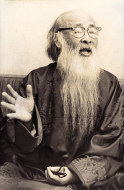| What is the life story of Zhang Daqian? Born in a family of artists in Neijiang, Sichuan Province, China, Zhang Daqian studied textile dyeing techniques in Kyoto, Japan and returned to establish a successful career selling his paintings in Shanghai. His original given name Chuan was later changed to Yuan, while his childhood name Chi was later incorporated into his studio name Chi-yuan. He took the religious name Dai-chien upon becoming a Buddhist monk, and after returning to the laity he called himself Dai-chien chu-shih or "Lay believer Dai-chien."
| 
|
At the age of 21 he studied under Tseng Hsi and Li Jui-ching. Taking Shih Tao and Pa-ta Shan-jen as his starting point, he tried to copy as many paintings by famous artists of past centuries as he could. Beginning with an impressionistic style and progressing to meticulous brushwork, he developed the ability to move between these techniques. In 1941 he traveled to DunHuang where he spent two years and seven months copying wall paintings. Here he studied traditional coloration and line drawing methods, being particularly moved by the grand scale and complex layout of the high Tang style. The sumptuous splendor of high Tang art inspired him with the desire to create great art. A staunch supporter of the Kuomintang, he left China in 1948 and moved to Mogi das Cruzes, Brazil, and then to Carmel, California, before finally settling in Taipei, Taiwan. A meeting between Zhang and Picasso in Antibes in 1953 was viewed as a summit between the preeminent masters of Eastern and Western art. The two men exchanged paintings at this meeting. |